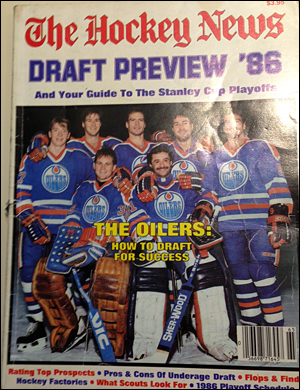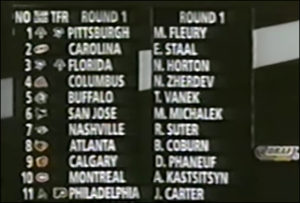Author Archives: Dan David
I don’t remember how I first became interested in player development and the NHL Entry Draft. Perhaps it was in early 1982, when I purchased my first copy of The Hockey News.
In high school at the time, I was really becoming more and more interested in hockey, and making a weekly 25-block trek through Manhattan to the closest newsstand that sold THN soon became a ritual.
That year, 1982, was also the moment that legendary hockey journalist and broadcaster Bob McKenzie began his nine-year run as editor of THN. McKenzie, who had covered junior hockey in Sault Ste. Marie before taking his editor’s job, and he had an obvious passion for both the CHL and the draft. He flooded THN’s pages with information about prospects and beefed up draft coverage to make THN the leading print authority on the draft.
It helped that McKenzie took the THN reins just two years before Mario Lemieux’s draft year. He was able to devote plenty of column inches to hyping Mario’s NHL arrival, and the young player did not disappoint. To this day, when The Hockey News throws its weight behind a player and predicts such greatness, I am quick to get on board with them, even if it means getting excited about a player like Alexandre Daigle.

Bob McKenzie and The Hockey News took the draft experience to a new and exciting level by publishing the first great draft preview guide.
By 1986, McKenzie had put together the first Hockey News Draft Preview, which as been a top-seller for the magazine ever since. Truly the original draft guide, it spawned a host of imitators, which ballooned with the Internet in the late 1990s. McKenzie’s draft guides were a breakthrough. Over the next several years, I spent countless hours poring over them, fueling my own passion for the draft
As a result, I have come to consider draft day one of the calendar year’s greatest dates. Being able to learn about the prospects in the weeks and months leading up to the draft — and then seeing which players go where — is as special to me now as it was 30 years ago.
After years of running this site, when I finally got a chance to work within the NHL, I knew I was going to learn as much as I could from scouts. I wanted to know how draft decisions get made. I came to realize that the brilliance of a good scout is his ability to look at a player today and project what he will be up to five years from now.
Being a star outside the NHL at 18 is no guarantee of making the transition to the next level. At the same time, having certain off-ice attributes can make up for on-ice deficiencies and open the door for an NHL career. I find this ability to project NHL players is as great as any talent the players themselves possess, and I am in awe of those who do it well.
Scouts I have met over the years are some of the nicest people I know, and when a team hoists the Stanley Cup, the scouting staff’s work should be applauded. Those guys are the real heroes of hockey.
Maybe that’s why draft day is so special for me. Because draft day is the one day of the year that belongs wholly to the scouting staffs. We get to see them do their thing and, a few years, later, see how well they did it. Even in a weaker year for talent such as this one, this process is still incredibly exciting — perhaps even more so because the diamonds in the rough are that much harder to find.
So, it’s time for another draft to unfold. Follow it here on this site (I’ll be making updates) or on some other site, but be sure to follow it. And as you watch it, ask yourself why certain players are being taken and certain others are being snubbed. Don’t forget to take notes, because it’s only a matter of time before you can determine the day’s winners and losers.
And in the meantime, as you wait for those results, there’s plenty of time to start learning about the prospects for 2018, 2019, and beyond.
In a little over three months, the hockey world will focus on Chicago for the 2017 NHL Entry Draft.
Draft Day is usually an eagerly-awaited event, when talented young players take their first steps toward pro careers. It is usually a time great excitement, as each club and its fans dream of the possibilities that come with new faces.
In other words, Draft Day is usually very special and worth its year-long wait.
But this year? Not so much.
Three months out, the hockey world should already realize that 2017 is not a strong draft year. In fact, it has all the signs of a classic weak one.
What factors make for an obviously strong or weak draft year? Consider these definitions:

This was the start of a strong draft year.
1. In a strong draft year, each team can reasonably expect to get a future NHL regular in the first round, and at least half the teams can expect to land a future All-Star. It is also clear that the second and third rounds will produce some gems that go to the teams with the best scouting staffs. In other words, a strong draft year is deep in talent, and this usually become evident by the time these players are 16-year-olds.
2. In a weak draft year, as many as half the teams picking in the first round can’t expect to get a future NHL regular, and only a handful (up to three or four) come away thinking they have a future All-Star. The second and third rounds both appear wide open with few or no potential gems. Thus, there is no real separation between players available late in the first round and those available in the third, and none of these players are guaranteed to play in the NHL. This is also evident by the time these players turn 16.
There have been many strong draft years of late, but let’s look back to 2003, one of the strongest ever. All 30 first-rounders reached the NHL, a group that included Marc-Andre Fleury, Eric Staal, Thomas Vanek, Ryan Suter, Dion Phaneuf, Jeff Carter, Dustin Brown, Zach Parise, Ryan Getlzaf, Corey Perry. That list goes on and on. Even the second round produced gems in Patrice Bergeron, Shea Weber, and David Backes.
Scouts who assessed the 2003 draft class understood this was a special group at least two years before Draft Day.
On the other hand, four years before the 2003 draft, the hockey world had to endure the painfully weak year that was 1999. Only two stars, Daniel and Henrik Sedin, came out of that first round, and they were only really available as a package deal. The vast majority of 1999 first-round picks, including No. 1 overall Patrik Stefan, are long forgotten. Three first-rounders never played a single NHL game, and there were no legitimate second- or third-round gems.
I was working at a sports website in 1999, covering that draft. I sensed something was wrong when I found myself hyping players like Branislav Mezei, Scott Kelman, and David Tanabe. I didn’t want to admit it at the time, but I knew I was dealing with a weak pool –something NHL scouts had known for years. Even players who were supposed to be good, like Pavel Brendl and Oleg Saprykin, were mediocre at best.
Is it a coincidence that players born during that forgettable draft year already look like a weak group overall? Maybe so, and maybe the future will prove me wrong, but it is hard to get up for the 2017 draft in much the same way it was hard to get excited about 1999.

Nolan Patrick (left) and Nico Hischier are talented players who will play in the NHL, but they don’t represent the level of top-two talent you would see in a strong draft year.
At the very top end of this year’s draft are players who would be considered lower first-round picks in most other years, and the league will be lucky if half of the top 30 players go on to have substantial NHL careers. Even the heavily-hyped players in the mix for No. 1 overall, Nolan Patrick and Nico Hischier, are far from can’t miss stars. Of the two, Patrick is the safer pick, while Hischier has greater upside. Still, it’s a reach to say either one of them is a future superstar or could change the fate of an NHL franchise.
If I had to pick one, I’d gamble and take Hischier, but this is hardly a choice between Connor McDavid and Jack Eichel or Auston Matthews and Patrik Laine. So there isn’t much reason to be counting the days until June. In a good draft year, nobody has to qualify their excitement like this. In a bad draft year, it’s the only way to keep your sanity. Swallow the medicine of 2017 and move on to 2018.
And that’s the silver lining here. Next year will be worth the wait for its very deep talent pool, because those 2018 players, most of whom are still 16, are miles ahead of where the 2017 crop was a year ago.
For the past few days, I was planning to write about why I believe the New York Rangers are an absolute lock to win this year’s Stanley Cup. I was going to explain how this year’s team was brilliantly built through the draft, free agency, and trades and how happy I will be for so many former MSG and Rangers co-workers when the Cup is presented to Ryan McDonagh in June.
I was going to write about how I felt fortunate to have been working for the team when almost all of the current homegrown players were drafted and how emotional it will be to see McDonagh pass the Cup to Henrik Lundqvist, who is truly one of the best people in the game and could not be more deserving of such an honor.
Of course, I still look forward to that Cup-lifting moment — and it will happen, believe me. However, that is all I can say about these Rangers just 48 hours from the start of the playoffs, because my thoughts today have been focused on the memory of someone who passed away nearly four weeks ago.
I wasn’t paying any attention to hockey headlines when Matthew Wuest lost his battle with cancer last month. Focused solely on hockey’s past, researching the history of major-junior drafts, I had little time for the present. And so, regrettably, I missed the news that Matt, best known as the creator of CapGeek.com, had passed away.
In some ways, I am thankful I did not learn of Matt’s death at the time. I knew for months that Matt had a terminal illness, but his loss is a devastating thing for me to digest and learning of it when he has already been laid to rest makes it somehow easier to absorb.
Flipping through The Hockey News pages today, I saw that Matt was gone. It was a surreal moment. I knew Matt when he dreamed of getting a by-line in The Hockey News, and here I was looking at a full-page obituary.
I spent the next two hours reviewing all the online coverage of his death, including the Halifax newspaper obituary, tributes from fellow hockey journalists and fans, and the numerous Twitter mentions of him in the days around this incredibly saddening news. I will continue to read anything and everything I can about Matt, but I have to write, too. Years from now, if someone searches Matt’s name online, I hope they will find this story in the mix.
Like so many others who have saluted Matt’s life, I never met him in person, but for almost 15 years he was a loyal friend. From the start, I was awed by his passion. As he made a name for himself in hockey, I was awed by his humility. And when I learned that he was so very ill, I was awed by his courage.
Life is random, and it is not fair. Period. There is no other rational way to explain how a person this selfless could be taken from all of us at such a young age.
I came to this very conclusion 21 years ago when my cousin, one of the kindest people I have ever known, passed away due to cancer at age 43. Matt was even younger — only 35 when he died last month — yet he had come a long, long way from when we first crossed paths.
It was the summer of 2000, and I was working at an ill-fated dot-com called Rival Networks. The company’s flagship website, Rivals.com, was ahead of its time in recognizing the demand for fan-generated sports content, but had no real way to monetize it. This was still a pre-broadband world and a time when people were leery of shopping online. Like so many other dot-coms in 2000, Rivals Networks was hoping for an IPO which would make its founders rich. Due to mismanagement and the dot-com collapse, the company never got to that point. (Side Note: The Rivals.com brand was later revived as a college football recruiting site by a small group of former employees and sold to Yahoo! for big money, but that’s another story.)
Armed with tens of millions of dollars in dot-com venture-capital funding, Rival Networks had managed to aggregate hundreds of the best unofficial sports team sites under one umbrella. At the time, it seemed ridiculous for amateurs to be writing about teams that wouldn’t even consider giving them press credentials, and it seemed even sillier to have ridiculously biased hockey fans trying to “report” on their favorite teams. My friends in mainstream journalism mocked me for joining such a company, and they were right in the sense that I would be out of work in only 11 months.
That 11-month ride that still seems like a dream. During those 11 months, I oversaw the company’s network of hockey sites, which drew most of their traffic from popular message boards. The words “blog” and “social media” probably didn’t exist at the time, Mark Zuckerberg was still in high school, and Twitter was five or six years away from existing, so those message boards were the cutting edge of interactivity.
Our Rivals.com Detroit Red Wings site was run by a fighter pilot named Barry. It didn’t have much traffic, because Barry was often busy flying jets and couldn’t put much time into working on it. As a result, Barry had to find an assistant to help him run the site.
That assistant ended up being a 19-year-old Canadian student named Matthew Wuest.
Although he had grown up in Maritime Canada, Matt was a die-hard Red Wings fan. He had discovered Barry’s site shortly after it launched in 1999 and really liked the Rival Networks concept. However, like most of the other people in our network, he had absolutely no experience as a journalist.
Matt was primarily interested in Red Wings draft picks and prospects, so he started out by helping Barry in that area. His early articles did not feel particularly professional, but they were always thorough, accurate, and highly informative. It was obvious that this kid from New Brunswick really, really cared about the Red Wings’ future.
He was particularly focused on a couple of European prospects named Henrik Zetterberg and Pavel Datsyuk, and he was tracking their progress on a daily basis. Both players were late-round picks, and very little was known about them in North America. Matt, however, was a true believer and did everything he could to alert Red Wings fans to their potential greatness. Matt, being Matt, was way ahead of his time.
As the months passed, Matt took more control of the Rivals Red Wings site. While Barry had been my initial phone contact, more of the conversations were now with Matt. These long-distance calls from Seattle to New Brunswick were probably costing our company a fortune. Matt was determined to learn everything he could about journalism, and it was refreshing to speak with a young person who shared my passion for hockey in general and the draft in particular.
At the time, Matt was studying computer science. Because of his computer skills, he was able to do some cool things on the Red Wings site, and he had an unbelievable work-ethic. In fact, I have yet to see another 20-year-old with that kind of dedication and I’m sure I never will.
Shortly before Rivals collapsed in April 2001, Matt told me he had decided that writing about hockey was his true calling and he would shift from computer science to journalism. I remember thinking it was crazy to give up computer science for what would be a far less lucrative career covering sports, but this kid was determined and he certainly wasn’t risk-averse.
When the Rivals.com run ended, Matt took all of his passion to his own site, RedWingsCentral.com. He built that site into everything a fan of Red Wings prospects could have dreamed of and began to establish connections in the scouting world. He would continue to publish that site for its loyal audience until just last year, when his declining health forced him to limit himself to CapGeek.
As he pursued his journalism degree, Matt began free-lancing for The Hockey News, and eventually became a sports reporter in Halifax, Nova Scotia, where he covered the local QMJHL team. Knowing Matt’s background, I always got a big kick out of reading his Hockey News pieces and seeing his QMJHL reporting online.
CapGeek was a spin-off of RedWingsCentral, which had ushered in the salary-cap era by providing contract and cap-hit information about the Red Wings alone. Given his natural coding ability, Matt was able to build something unique, and he had the foresight to realize he could expand his salary and contract database to cover the entire NHL — thereby filling a need that the league refused to address.
He did just that, and he revolutionized the world of hockey in the process. Everyone in the business used CapGeek for salary-related information. I remember seeing Cam Hope, then the assistant general manager of the Rangers, going through the CapGeek site one day and telling him I knew the guy who created it. Cam, who had helped put together all of the Rangers players’ actual contracts, said CapGeek was roughly 95 percent accurate in the case of the Rangers, and he marveled at how Matt Wuest was getting his information from player agents and other sources.
In 2011, I remember the excitement I felt when Matt was ranked No. 98 on The Hockey News‘ annual list of the 100 most powerful people in hockey. The kid from the phone calls had made it to the game’s stratosphere. It hardly surprised me. From those first conversations I had with him in 2000, I sensed that this person was destined to forever impact the game he loved. If it ever becomes possible for the Hockey Hall of Fame to honor online achievements in the way it honors writers and broadcasters, I would hope the award could be named for Matt.
The most impressive thing — and the thing I will always remember about Matt — was his remarkable humility and respect for the game. In a world of obnoxious bloggers and shameless self-promoters, Matt was never interested in the spotlight, and he was not about big money. There are dot-com dreamers out there who would give anything for what Matt had, but he cared about a bigger picture and was constantly sharing his love for hockey. He responded to every question that came his way and took every fan’s online request seriously, never forgetting that he was once one of them.
He also never forgot people he met along the way. When I started a twitter account for HockeyDraftCentral, Matt was the second person to follow me, even though I had not had e-mail contact with him in a couple of years. Last summer, I e-mailed him to ask if there was some way I could help him build out historical information on CapGeek, and I was genuinely excited about the prospect of working with him again after all these years.
Matt didn’t respond to that e-mail for several weeks, which wasn’t like him at all. But I had no idea he was nearly two years into a battle for his life. Then, in August, he e-mailed me to let me know that he couldn’t take me up on my offer because of his illness, which was not public information at the time.
I was stunned and saddened to learn he was sick, but I somehow thought that he was going to beat cancer. I had seen this young man go from obscurity in a New Brunswick computer-science program to the THN top 100. I had to believe that no matter how sick he was, he would find a way to survive.
I had one more e-mail exchange with Matt last November. He was going in for another round of treatment and seemed hopeful. He mentioned that he and Ottawa Senators GM Bryan Murray were fighting the exact same thing despite the big gap in their ages. It suddenly struck me that I had once met Bryan Murray in person but had never actually been in the same room as Matt.
So I knew he was sick, but subconsciously, I was avoiding the reality that his time was so limited. I hadn’t checked CapGeek since he shut it down in January, so I didn’t realize his health had declined so rapidly from November. I suppose that’s something I was afraid to know.
And now he is gone, and hockey will never be the same for his loss. He was remembered in most tribute pieces as an online pioneer, a person of great humility, a friend to all hockey fans and an inspiration to hockey writers. He was indeed all of those things, but none of those journalists had known Matt before he had joined their ranks. Few may have understood just how far he had come.
I will forever remember Matt as the young man on the phone going on to reach heights that might have seemed unimaginable. I was 34 when I had my first conversation with Matt. He was 35 when he died. In those intervening 15 years, he touched the lives of millions of hockey fans who spent countless hours interacting with both him and his work.
I have been looking forward to this year’s Stanley Cup playoffs for a long time, and I fully expect to feel a lot of happiness for a lot of Rangers people in June. But if any other team proves me wrong and takes the Cup instead of this great Rangers team, I want it to be the Detroit Red Wings. And no matter what happens during these playoffs, I will be thinking a lot about Matthew Wuest and how grateful I am to have known one of 21st century hockey’s most important and ground-breaking people.

